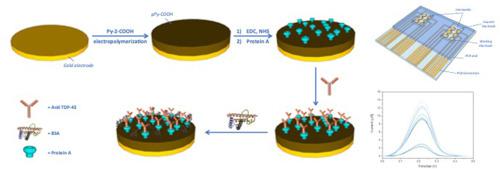Our official English website, www.x-mol.net, welcomes your feedback! (Note: you will need to create a separate account there.)
Advancing amyotrophic lateral sclerosis disease diagnosis: A lab-on-chip electrochemical immunosensor for ultra-sensitive TDP-43 protein detection and monitoring in serum patients’
Talanta ( IF 6.1 ) Pub Date : 2024-03-06 , DOI: 10.1016/j.talanta.2024.125866 Antonio Turco , Elisabetta Primiceri , Maria Serena Chiriacò , Velia La Pesa , Francesco Ferrara , Nilo Riva , Angelo Quattrini , Alessandro Romano , Giuseppe Maruccio
Talanta ( IF 6.1 ) Pub Date : 2024-03-06 , DOI: 10.1016/j.talanta.2024.125866 Antonio Turco , Elisabetta Primiceri , Maria Serena Chiriacò , Velia La Pesa , Francesco Ferrara , Nilo Riva , Angelo Quattrini , Alessandro Romano , Giuseppe Maruccio

|
The global increase in population aging has led to a rise in neurodegenerative diseases (NDs), posing significant challenges to public health. Developing selective and specific biomarkers for early diagnosis and drug development is crucial addressing the growing burden of NDs. In this context, the RNA-binding protein TDP-43 has emerged as a promising biomarker for amyotrophic lateral sclerosis (ALS), frontotemporal lobar degeneration (FTLD), and TDP-43-associated proteinopathies. However, existing detection methods suffer from limitations such as cost, complexity, and operator dependence. Here, we present a novel electrochemical biosensor integrated into a lab-on-chip (LoC) platform to detect TDP-43. The sensor utilizes electrosynthesized polypyrrole derivatives with carboxylic groups for transducer functionalization, enabling targeted immobilization of TDP-43 antibodies. Differential pulsed voltammetry (DPV) is used for the indirect detection and quantification of TDP-43. The chip exhibits rapid response, good reproducibility, a linear detection range, and sensitivity from 0.01 ng/mL to 25 ng/mL of TDP-43 protein concentration with a LOD = 10 pg/mL. Furthermore, successful TDP-43 detection in complex matrices like serum of ALS patients and healthy individuals demonstrates its potential as a point-of-care diagnostic device. This electrochemical biosensor integrated into a chip offers good sensitivity, rapid response, and robust performance, providing a promising avenue for advancing neurodegenerative disease diagnostics and therapeutic development.
中文翻译:

推进肌萎缩侧索硬化症诊断:用于超灵敏 TDP-43 蛋白检测和监测患者血清的实验室芯片电化学免疫传感器
全球人口老龄化加剧导致神经退行性疾病(ND)增加,给公共健康带来重大挑战。开发用于早期诊断和药物开发的选择性和特异性生物标志物对于解决新城疫日益增长的负担至关重要。在这种情况下,RNA 结合蛋白 TDP-43 已成为肌萎缩侧索硬化症 (ALS)、额颞叶变性 (FTLD) 和 TDP-43 相关蛋白病的有前途的生物标志物。然而,现有的检测方法受到成本、复杂性和操作员依赖性等限制。在这里,我们提出了一种集成到芯片实验室 (LoC) 平台中的新型电化学生物传感器来检测 TDP-43。该传感器利用带有羧基的电合成聚吡咯衍生物进行传感器功能化,从而实现 TDP-43 抗体的靶向固定。微分脉冲伏安法 (DPV) 用于 TDP-43 的间接检测和定量。该芯片具有快速响应、良好的重现性、线性检测范围和 TDP-43 蛋白浓度为 0.01 ng/mL 至 25 ng/mL 的灵敏度,LOD = 10 pg/mL。此外,在 ALS 患者和健康个体的血清等复杂基质中成功检测 TDP-43 证明了其作为即时诊断设备的潜力。这种集成到芯片中的电化学生物传感器具有良好的灵敏度、快速的响应和强大的性能,为推进神经退行性疾病诊断和治疗开发提供了一条有前途的途径。
更新日期:2024-03-06
中文翻译:

推进肌萎缩侧索硬化症诊断:用于超灵敏 TDP-43 蛋白检测和监测患者血清的实验室芯片电化学免疫传感器
全球人口老龄化加剧导致神经退行性疾病(ND)增加,给公共健康带来重大挑战。开发用于早期诊断和药物开发的选择性和特异性生物标志物对于解决新城疫日益增长的负担至关重要。在这种情况下,RNA 结合蛋白 TDP-43 已成为肌萎缩侧索硬化症 (ALS)、额颞叶变性 (FTLD) 和 TDP-43 相关蛋白病的有前途的生物标志物。然而,现有的检测方法受到成本、复杂性和操作员依赖性等限制。在这里,我们提出了一种集成到芯片实验室 (LoC) 平台中的新型电化学生物传感器来检测 TDP-43。该传感器利用带有羧基的电合成聚吡咯衍生物进行传感器功能化,从而实现 TDP-43 抗体的靶向固定。微分脉冲伏安法 (DPV) 用于 TDP-43 的间接检测和定量。该芯片具有快速响应、良好的重现性、线性检测范围和 TDP-43 蛋白浓度为 0.01 ng/mL 至 25 ng/mL 的灵敏度,LOD = 10 pg/mL。此外,在 ALS 患者和健康个体的血清等复杂基质中成功检测 TDP-43 证明了其作为即时诊断设备的潜力。这种集成到芯片中的电化学生物传感器具有良好的灵敏度、快速的响应和强大的性能,为推进神经退行性疾病诊断和治疗开发提供了一条有前途的途径。



























 京公网安备 11010802027423号
京公网安备 11010802027423号